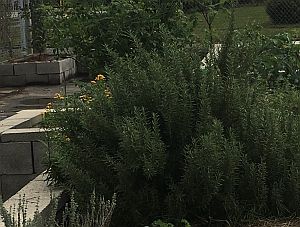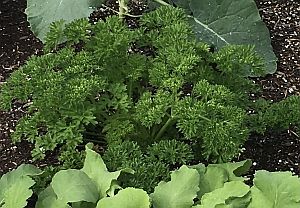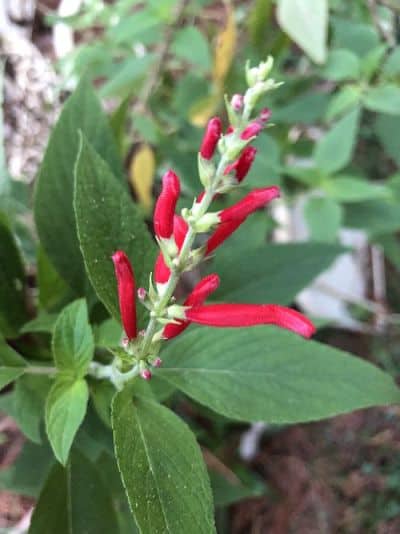(Image above: Pineapple Sage)
Cool Season Herb Gardening
Now is a great time to plant many of the hardy herbs used to cook. These herbs establish well when planted during the mild weather we have this time of the year. Winter cold will not hurt hardy herbs, and they grow vigorously during mild weather. Fall-planted hardy herbs are far more productive when compared to planting them in spring.
In Louisiana, we can group herbs into groups of cool-season annuals, warm-season annuals and perennials. Annuals live for one season and then die. Cool-season annuals grow from October to May, and warm-season annuals grow from April to November. Perennial herbs live for several years. This time of year, we can plant cool-season annual herbs and hardy perennial herbs.

(Image left: Mint)
Cool-season annual herbs are not bothered by winter freezes and prefer to grow in the cool to mild days and chilly to cold nights we have here during the cool season. Transplants should be planted from October through March. You can expect to get a decent harvest when cool-season annual herb transplants are put out in spring. Plant the largest transplants you can find. Fall plantings will produce the largest and longest harvest. Herbs we grow as cool-season annuals include parsley, cilantro/coriander, celery, dill, chicory, fennel, borage, arugula and chervil.
Perennial herbs are also generally not bothered by winter cold. Most of the perennial herbs are best planted from September through April using transplants found at our local nurseries. Fall planting allows these herbs to establish during the less-stressful cool season. There is less disease and pressure from pests. Some of the perennial herbs that do well here and can be planted now are mints, lemon balm, rosemary, burnet, sorrel, catmint, garlic chives, oregano, thyme, sage, lavender, monarda, catnip, anise hyssop, mountain mint, French bay, pineapple sage and rue. A few perennial herbs that like the heat and would rather be planted in spring include Mexican tarragon, lemon verbena, lemon grass and society garlic.
Some perennial herbs are especially sensitive to heat, so they’re always best planted in fall. Thyme, sage, catnip and lavender fall into this category. Although they generally thrive in the garden during the cool season from October to early May, they struggle during our hot, humid summers. By planting in fall, these herbs will be better established and more likely to make it through the summer than when they are planted in spring.
(Image right: Rosemary)

Thyme, sage, catnip and lavender require excellent drainage to survive the summer as they are prone to root rot during hot weather. They may be more successful when grown in a raised bed or containers and placed in a location that gets some shade in the summer afternoon.
Several perennial herbs almost never survive our summers and are best grown here as cool-season annuals. Transplants are planted in fall, grow vigorously over winter and produce harvests into spring. As the weather gets hot, they typically lose vigor and die in early to midsummer. Perennial herbs in this category include French tarragon, feverfew and chamomile.
Most herbs require direct sun at least four to six hours a day and excellent drainage. Raised beds are a good idea for many herbs because of our significant yearly rainfall. Herbs should be fertilized moderately to avoid stimulating lush growth that will be less flavorful. Generally, fertilize herbs with the same products you use for your other plants but at about half the amount.

(Image left: Curly Parsley)
Position your herbs close to the kitchen so they are convenient to use while you are cooking. Herbs grow very well in containers or raised beds. As an alternative to an in-ground garden near your kitchen, you can locate pots of herbs on a back porch, deck or patio to be convenient. And because you don’t generally need more than one to a few plants of each type of herb, a nice container herb garden does not have to include a huge number of pots. Herbs may be grown as ornamentals but are intended to be harvested regularly to flavor and enrich your home cooking.
Two herb soil recipes shared from presentation by Master Gardener of Greater New Orleans, Usha Ramadhyani:
Anna Timmerman’s Herb Soil Mix Recipe
- 2 bags Peat Moss (3 cu. ft bags)
- 2 Bags Black Kow Compost (50lbs. bag)
- 1 Large Bag perlite (2 cu. ft.)
- 4 Bags Miracle Grow Cactus, Palm and Citrus Potting Mix (8 qt. bags)
Makes enough to fill 16 five-gallon pots. Will make 11 cubic feet of soil
Pelican Greenhouse Herb Soil Mix
- 1 bucket soil compost (5 gallon bucket)
- 4 green scoops of Pro Mix (1 scoop is about 4 cups)
- ½ plus plastic cup of granular fertilizer
Information for garden tips taken from article by Dan Gill, retired Horticulturist LSU AgCenter.
Soil recipes from presentation on Winter Herbs by Usha Ramadhyani, MGGNO.

By Karen Blackburn

